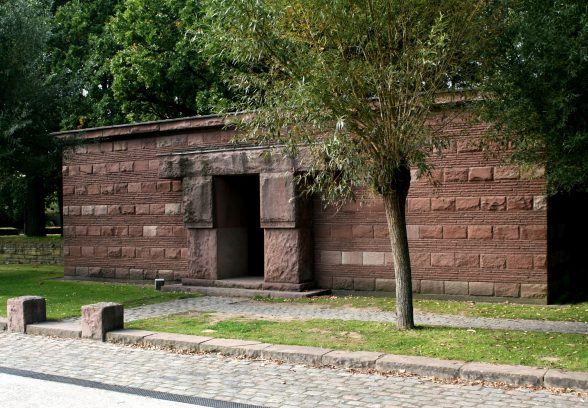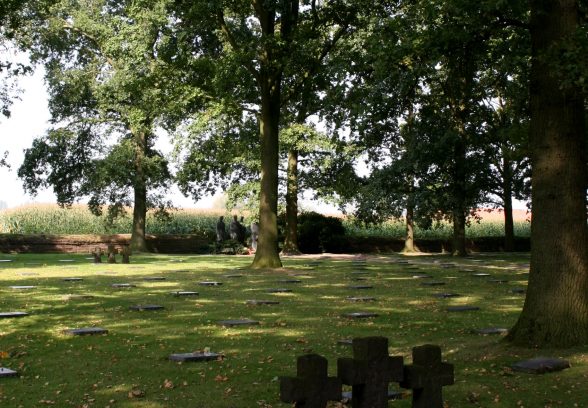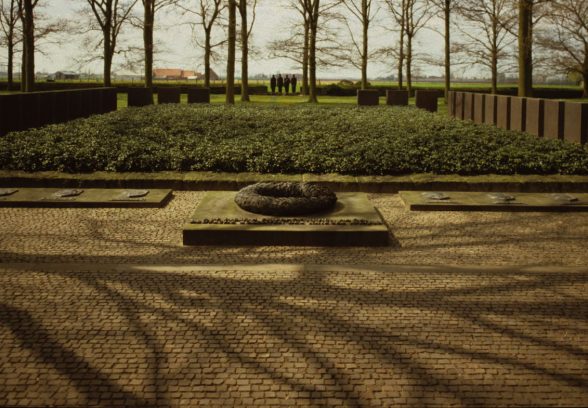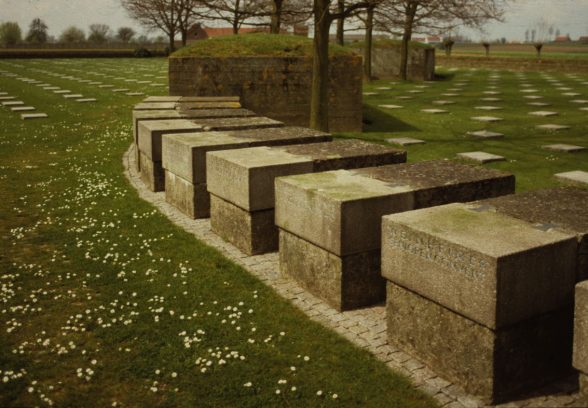This website uses cookies
This website uses cookies to enable it to function properly and to analyse how the website is used. Please click 'Close' to accept and continue using the website.







Belgium: Langemark Deutsche Soldatenfriedhof, German Military Cemetery
Architect: Robert Tischler
Owners: Volksbund Deutsche Kriegsgräberfürsorge
Location: Langemark-Poelkapell, West-Vlaanderen
Out of her total loss of almost two million, Germany left 135,000 of her dead of the Great War in Belgium, together with possibly as many as 90,000 missing. Most of these men died around Ypres. Their graves were originally scattered in 270 different places. The German counterpart to the IWGC, the Volksbund Deutsche Kriegsgräberfürsorge, was established in 1919. In 1926 a construction team was established under the Volksbund’s chief architect, Robert Tischler. It was decided not to have a uniform style or manner of treatment, as with the British war graves, but to design each cemetery to blend in with the landscape and be comparatively easy to maintain. Nevertheless, the buildings and memorials by Tischler – a Munich landscape architect – have a recognisable style and are impressive designs which exploit the power of rough masonry and of simple masses. His cemeteries in Belgium were characterised by rugged masonry buildings of dark red Weser sandstone and by the planting of oak trees.
Agreement had been reached with the Belgian government in 1925 for the Official German Burial Service in Belgium to organise the exhumation and reburial of Germany’s war dead in a series of cemeteries. After the Second World War, agreement was again reached with the Belgian government for the Federal Republic of Germany to maintain the war graves in Belgium again. Between 1956 and 1958 the bodies in 128 cemeteries in Belgium were exhumed and reburied in three enlarged collecting cemeteries, at Langemark, Vladslo and Menen, leaving two smaller German cemeteries at Hooglede and Zeebrugge. At the same time, these three cemeteries were restored and altered by Tischler, their original architect, shortly before he died in 1958. This work was finally completed in 1970-72.
Langemark, originally called Langemarck-Nord, is the most important of the German war cemeteries in Belgium and now contains the remains of 44,292 soldiers. A cemetery was first made here in 1915 and the permanent cemetery was inaugurated in 1932. The powerful and rugged lodge building, with its wrought-iron gates, was designed by Tischler. Inside, one chamber bears the names of missing soldiers on oak panels; the other has a map carved on a wall showing of all the original German cemeteries in Belgium. Today, the entrance leads immediately to the Kameradengrab, a mass grave, containing 24,917 bodies. The names of 17,342 dead known to be among them are cast on free-standing bronze stele placed along the perimeter. At the far end, terminating the axis from the entrance, are four bronze sculptures of mourning soldiers by Emil Krieger dating from 1956 (moved to their present position in 1984). Elsewhere, 10,143 bodies lie under lettered squares of granite placed on the ground, which replaced the original wooden crosses.
The northern boundary of the cemetery was originally formed by three reinforced-concrete bunkers of the defensive Langemark Line. These were connected by blocks of stone and concrete bearing regimental and other symbols. Beyond this line is the former “poppy field” which is now an extension to the cemetery containing the graves of a further 9,475 men moved here in the 1950s. A high proportion of the casualties buried here were student volunteers. Exempted from military service while they pursued their studies at university or high school, they – together with their teachers – volunteered in huge numbers in 1914, inspired by that wave of enthusiastic patriotism which affected all the fighting powers at the beginning of the Great War. Inadequately trained, they were mown down by rapid rifle fire by the professionals of the British Expeditionary Force in the First Battle of Ypres – the abortive assault on Ypres in October-November 1914 which resulted in 50,000 German casualties to 24,000 British. This Kindermord bei Ypern – “Massacre of the Innocents” – would have tragic consequences, for among the young volunteers who survived the slaughter at Langemark in 1914 were the future novelist Ernst Jünger and a would-be Austrian artist serving with a Bavarian division called Adolf Hitler. Langemark is a powerful, sombre place. John Keegan once wrote that a visit to this German war cemetery is necessary to understand the subsequent terrible history of the 20th century:
“It was Hitler’s presence at and survival of Ypres which makes Langemark a place as significant in history as the Bastille or Sarajevo. For it is, in a real sense, the birthplace of the Second World War. Hitler, in volunteering to serve the Kaiser, demonstrated his acceptance of the central 19th-century belief that to be a citizen a man must be a soldier. It was that belief which created the armies of millions that the war slaughtered in millions. Hitler, to whom the war remained ‘the supreme experience’, never reconciled himself to the pointlessness of his comrades’ deaths at Langemark or to the narrowness of the margin by which Germany had been denied victory in 1918. The whole of his struggle for and seizure of power was dedicated to paying back the victors, five, ten and a hundredfold, for the sufferings of his dead comrades and those millions of German mothers to whom the telegrams came.” [Daily Telegraph 11.11.88]
A sunken visitor centre was opened last year at Langemark, designed, like the one at Tyne Cot, by Benny Govaerts & Damiaan Vanhoutte.
Gavin Stamp
Either enter the name of a place or memorial or choose from the drop down list. The list groups memorials in London and then by country

Become a C20 member today and help save our modern design heritage.